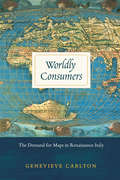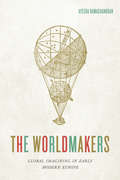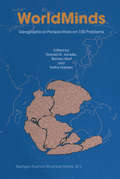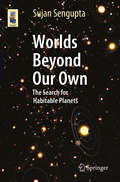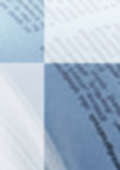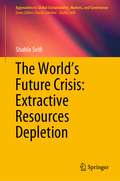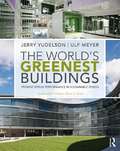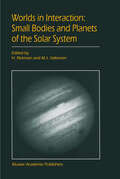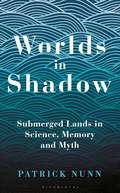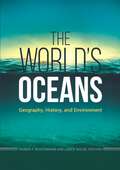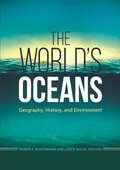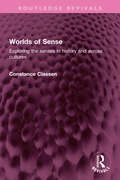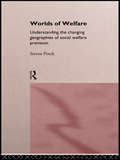- Table View
- List View
Worldly Consumers: The Demand for Maps in Renaissance Italy
by Genevieve CarltonThough the practical value of maps during the sixteenth century is well documented, their personal and cultural importance has been relatively underexamined. In Worldly Consumers, Genevieve Carlton explores the growing availability of maps to private consumers during the Italian Renaissance and shows how map acquisition and display became central tools for constructing personal identity and impressing one’s peers. Drawing on a variety of sixteenth-century sources, including household inventories, epigrams, dedications, catalogs, travel books, and advice manuals, Worldly Consumers studies how individuals displayed different maps in their homes as deliberate acts of self-fashioning. One citizen decorated with maps of Bruges, Holland, Flanders, and Amsterdam to remind visitors of his military prowess, for example, while another hung maps of cities where his ancestors fought or governed, in homage to his auspicious family history. Renaissance Italians turned domestic spaces into a microcosm of larger geographical places to craft cosmopolitan, erudite identities for themselves, creating a new class of consumers who drew cultural capital from maps of the time.
Worldly Wonder: Religions Enter Their Ecological Phase (Master Hsüan Hua Memorial Lecture Ser. (PDF))
by Mary Evelyn Tucker Judith A. BerlingHistory illustrates the power of religion to bring about change. Mary Evelyn Tucker describes how world religions have begun to move from a focus on God-human and human-human relations to encompass human-earth relations. She argues that, in light of the environmental crisis, religion should move from isolated orthodoxy to interrelated dialogue and use its authority for liberation rather than oppression.
The Worldmakers: Global Imagining in Early Modern Europe
by Ayesha RamachandranIn this beautifully conceived book, Ayesha Ramachandran reconstructs the imaginative struggles of early modern artists, philosophers, and writers to make sense of something that we take for granted: the world, imagined as a whole. Once a new, exciting, and frightening concept, “the world” was transformed in the sixteenth and seventeenth centuries. But how could one envision something that no one had ever seen in its totality? The Worldmakers moves beyond histories of globalization to explore how “the world” itself—variously understood as an object of inquiry, a comprehensive category, and a system of order—was self-consciously shaped by human agents. Gathering an international cast of characters, from Dutch cartographers and French philosophers to Portuguese and English poets, Ramachandran describes a history of firsts: the first world atlas, the first global epic, the first modern attempt to develop a systematic natural philosophy—all part of an effort by early modern thinkers to capture “the world” on the page.
The Worldmakers: Global Imagining in Early Modern Europe
by Ayesha RamachandranIn this beautifully conceived book, Ayesha Ramachandran reconstructs the imaginative struggles of early modern artists, philosophers, and writers to make sense of something that we take for granted: the world, imagined as a whole. Once a new, exciting, and frightening concept, “the world” was transformed in the sixteenth and seventeenth centuries. But how could one envision something that no one had ever seen in its totality? The Worldmakers moves beyond histories of globalization to explore how “the world” itself—variously understood as an object of inquiry, a comprehensive category, and a system of order—was self-consciously shaped by human agents. Gathering an international cast of characters, from Dutch cartographers and French philosophers to Portuguese and English poets, Ramachandran describes a history of firsts: the first world atlas, the first global epic, the first modern attempt to develop a systematic natural philosophy—all part of an effort by early modern thinkers to capture “the world” on the page.
The Worldmakers: Global Imagining in Early Modern Europe
by Ayesha RamachandranIn this beautifully conceived book, Ayesha Ramachandran reconstructs the imaginative struggles of early modern artists, philosophers, and writers to make sense of something that we take for granted: the world, imagined as a whole. Once a new, exciting, and frightening concept, “the world” was transformed in the sixteenth and seventeenth centuries. But how could one envision something that no one had ever seen in its totality? The Worldmakers moves beyond histories of globalization to explore how “the world” itself—variously understood as an object of inquiry, a comprehensive category, and a system of order—was self-consciously shaped by human agents. Gathering an international cast of characters, from Dutch cartographers and French philosophers to Portuguese and English poets, Ramachandran describes a history of firsts: the first world atlas, the first global epic, the first modern attempt to develop a systematic natural philosophy—all part of an effort by early modern thinkers to capture “the world” on the page.
The Worldmakers: Global Imagining in Early Modern Europe
by Ayesha RamachandranIn this beautifully conceived book, Ayesha Ramachandran reconstructs the imaginative struggles of early modern artists, philosophers, and writers to make sense of something that we take for granted: the world, imagined as a whole. Once a new, exciting, and frightening concept, “the world” was transformed in the sixteenth and seventeenth centuries. But how could one envision something that no one had ever seen in its totality? The Worldmakers moves beyond histories of globalization to explore how “the world” itself—variously understood as an object of inquiry, a comprehensive category, and a system of order—was self-consciously shaped by human agents. Gathering an international cast of characters, from Dutch cartographers and French philosophers to Portuguese and English poets, Ramachandran describes a history of firsts: the first world atlas, the first global epic, the first modern attempt to develop a systematic natural philosophy—all part of an effort by early modern thinkers to capture “the world” on the page.
The Worldmakers: Global Imagining in Early Modern Europe
by Ayesha RamachandranIn this beautifully conceived book, Ayesha Ramachandran reconstructs the imaginative struggles of early modern artists, philosophers, and writers to make sense of something that we take for granted: the world, imagined as a whole. Once a new, exciting, and frightening concept, “the world” was transformed in the sixteenth and seventeenth centuries. But how could one envision something that no one had ever seen in its totality? The Worldmakers moves beyond histories of globalization to explore how “the world” itself—variously understood as an object of inquiry, a comprehensive category, and a system of order—was self-consciously shaped by human agents. Gathering an international cast of characters, from Dutch cartographers and French philosophers to Portuguese and English poets, Ramachandran describes a history of firsts: the first world atlas, the first global epic, the first modern attempt to develop a systematic natural philosophy—all part of an effort by early modern thinkers to capture “the world” on the page.
The Worldmakers: Global Imagining in Early Modern Europe
by Ayesha RamachandranIn this beautifully conceived book, Ayesha Ramachandran reconstructs the imaginative struggles of early modern artists, philosophers, and writers to make sense of something that we take for granted: the world, imagined as a whole. Once a new, exciting, and frightening concept, “the world” was transformed in the sixteenth and seventeenth centuries. But how could one envision something that no one had ever seen in its totality? The Worldmakers moves beyond histories of globalization to explore how “the world” itself—variously understood as an object of inquiry, a comprehensive category, and a system of order—was self-consciously shaped by human agents. Gathering an international cast of characters, from Dutch cartographers and French philosophers to Portuguese and English poets, Ramachandran describes a history of firsts: the first world atlas, the first global epic, the first modern attempt to develop a systematic natural philosophy—all part of an effort by early modern thinkers to capture “the world” on the page.
WorldMinds: Commemorating the 100th Anniversary of the Association of American Geographers 1904–2004
by Donald G. Janelle Barney Warf Kathy HansenWorldMinds provides broad exposure to a geography that is engaged with discovery, interpretation, and problem solving. Its 100 succinct chapters demonstrate the theories, methods, and data used by geographers, and address the challenges posed by issues such as globalization, regional and ethnic conflict, environmental hazards, terrorism, poverty, and sustainable development. Through its theoretical and practical applications, we are reminded that the study of Geography informs policy making.
Worlds Beyond Our Own: The Search for Habitable Planets (Astronomers' Universe)
by Sujan SenguptaThis is a book on planets: Solar system planets and dwarf planets. And planets outside our solar system – exoplanets. How did they form? What types of planets are there and what do they have in common? How do they differ? What do we know about their atmospheres – if they have one? What are the conditions for life and on which planets may they be met? And what’s the origin of life on Earth and how did it form? You will understand how rare the solar system, the Earth and hence life is.This is also a book on stars. The first and second generation of stars in the Universe. But in particular also on the link between planets and stars – brown dwarfs. Their atmospheric properties and similarities with giant exoplanets.All these fascinating questions will be answered in a non-technical manner. But those of you who want to know a bit more may look up the relevant mathematical relationships in appendices.
The World's Fastest Growing Cities (large print)
by RnibThis page shows a map of the world with ten cities marked. There is a locator dot shown, which will be at the top left, when the image is the correct way up. The image is surrounded by an image border. The sea is shown as a textured area (pale blue on large print image) surrounding the land. There is a small key in the bottom left of the page explaining the textures used on the land. The cities are shown by an open circle symbol. They are: 1 Mexico City 2 Sao Paulo 3 Karachi 4 Delhi 5 Mumbai (Bombay) 6 Kolkata (Calcutta) 7 Dhaka 8 Jakarta 9 Seoul 10 Tokyo
The World's Fastest Growing Cities (UEB contracted)
by RnibThis page shows a map of the world with ten cities marked. There is a locator dot shown, which will be at the top left, when the image is the correct way up. The image is surrounded by an image border. The sea is shown as a textured area (pale blue on large print image) surrounding the land. There is a small key in the bottom left of the page explaining the textures used on the land. The cities are shown by an open circle symbol. They are: 1 Mexico City 2 Sao Paulo 3 Karachi 4 Delhi 5 Mumbai (Bombay) 6 Kolkata (Calcutta) 7 Dhaka 8 Jakarta 9 Seoul 10 Tokyo
The World's Fastest Growing Cities (UEB uncontracted)
by RnibThis page shows a map of the world with ten cities marked. There is a locator dot shown, which will be at the top left, when the image is the correct way up. The image is surrounded by an image border. The sea is shown as a textured area (pale blue on large print image) surrounding the land. There is a small key in the bottom left of the page explaining the textures used on the land. The cities are shown by an open circle symbol. They are: 1 Mexico City 2 Sao Paulo 3 Karachi 4 Delhi 5 Mumbai (Bombay) 6 Kolkata (Calcutta) 7 Dhaka 8 Jakarta 9 Seoul 10 Tokyo
The World’s Future Crisis: Extractive Resources Depletion (Approaches to Global Sustainability, Markets, and Governance)
by Shahla SeifiThis book focuses mainly on strategic decision making at a global level, which is rarely considered in approaches to sustainability. This book makes a unique contribution as the work looks at global consequences of mineral exhaustion and steps that can be taken to alleviate the impending problems. This book highlights how sustainability has become one of the most important issues for businesses, governments and society at large. This book explores the topic of sustainability as one that is under much debate as to what it actually is and how it can be achieved, but it is completely evident that the resources of the planet are fixed in quantity, and once used, cannot be reused except through being reused in one form or another. This is particularly true of the mineral resources of the planet. These are finite in quantity, and once fully extracted, extra quantities are no longer available for future use. This book argues and presents evidence that the remaining mineral resources are diminishing significantly and heading towards exhaustion. Once mined and consumed, they are no longer available for future use other than what can be recycled and reused. This book demonstrates that future scarcity means that best use must be made of what exists, as sustainability depends upon this, and best use is defined as utility rather than economic value, which must be considered at a global level rather than a national level. Moreover, sustainability depends upon both availability in the present and in the future, so the use of resources requires attention to the future as well as to the present. This book investigates the alternative methods of achieving the global distribution of these mineral resources and proposes an optimum solution. This book adds to the discourse through the understanding of the importance of the depletion and finiteness of raw materials and their use for the present and the future, in order to achieve and maintain sustainability.
The World's Greenest Buildings: Promise Versus Performance in Sustainable Design
by Jerry Yudelson Ulf MeyerThe World’s Greenest Buildings tackles an audacious task. Among the thousands of green buildings out there, which are the best, and how do we know? Authors Jerry Yudelson and Ulf Meyer examined hundreds of the highest-rated large green buildings from around the world and asked their owners to supply one simple thing: actual performance data, to demonstrate their claims to sustainable operations. This pivotal book presents: an overview of the rating systems and shows "best in class" building performance in North America, Europe, the Middle East, India, China, Australia and the Asia-Pacific region practical examples of best practices for greening both new and existing buildings a practical reference for how green buildings actually perform at the highest level, one that takes you step-by-step through many different design solutions a wealth of exemplary case studies of successful green building projects using actual performance data from which to learn interviews with architects, engineers, building owners and developers and industry experts, to provide added insight into the greening process This guide uncovers some of the pitfalls that lie ahead for sustainable design, and points the way toward much faster progress in the decade ahead.
The World's Greenest Buildings: Promise Versus Performance in Sustainable Design
by Jerry Yudelson Ulf MeyerThe World’s Greenest Buildings tackles an audacious task. Among the thousands of green buildings out there, which are the best, and how do we know? Authors Jerry Yudelson and Ulf Meyer examined hundreds of the highest-rated large green buildings from around the world and asked their owners to supply one simple thing: actual performance data, to demonstrate their claims to sustainable operations. This pivotal book presents: an overview of the rating systems and shows "best in class" building performance in North America, Europe, the Middle East, India, China, Australia and the Asia-Pacific region practical examples of best practices for greening both new and existing buildings a practical reference for how green buildings actually perform at the highest level, one that takes you step-by-step through many different design solutions a wealth of exemplary case studies of successful green building projects using actual performance data from which to learn interviews with architects, engineers, building owners and developers and industry experts, to provide added insight into the greening process This guide uncovers some of the pitfalls that lie ahead for sustainable design, and points the way toward much faster progress in the decade ahead.
Worlds in Interaction: Proceedings of the Meeting “Small Bodies in the Solar System and their Interactions with the Planets” held in Mariehamn, Finland, August 8–12, 1994
by Hans Rickman M. J. ValtonenPlanet Earth is part of our Galactic environment, not just the product of it, and it is still today influenced by phenomena related to Galactic forces. Specifically, our planet is affected by its near environment, in particular the small bodies in the Solar System. This book reviews the processes which cause the collisions of these small bodies with the Earth as well as the consequences of such collisions. The various articles take the reader through the Galaxy-Solar System connection to the orbital dynamics of the small bodies and to their number and distribution in near-Earth space. The hazards of the impacts of small bodies on Earth are evaluated, and the geophysical records of such impacts are discussed. The book takes the reader to the forefront of research on both impact cratering and the origin and evolution of small bodies in the Solar System. Thus it brings together two subjects, geophysics and astronomy, which are usually discussed in separate volumes but are closely knit together in this particular area of research.
Worlds in Shadow: Submerged Lands in Science, Memory and Myth
by Patrick NunnThe traces of much of human history – and that which preceded it – lie beneath the ocean surface; broken up, dispersed, often buried and always mysterious. This is fertile ground for speculation, even myth-making, but also a topic on which geologists and climatologists have increasingly focused in recent decades. We now know enough to tell the true story of some of the continents and islands that have disappeared throughout Earth's history, to explain how and why such things happened, and to unravel the effects of submergence on the rise and fall of human civilizations. In Worlds in Shadow Patrick Nunn sifts the facts from the fiction, using the most up-to-date research to work out which submerged places may have actually existed versus those that probably only exist in myth. He looks at the descriptions of recently drowned lands that have been well documented, those that are plausible, and those that almost certainly didn't exist. Going even further back, Patrick examines the presence of more ancient lands, submerged beneath the waves in a time that even the longest-reaching folk memory can't touch. Such places may have played important roles in human evolution, but can only be reconstructed through careful geological detective work. Exploring how lands become submerged, whether from sea-level changes, tectonic changes, gravity collapse, giant waves or volcanoes, helps us determine why, when and where land may disappear in the future, and what might be done to prevent it.
The World's Oceans: Geography, History, and Environment
by Rainer F. Buschmann Lance NoldeThis single-volume resource explores the five major oceans of the world, addressing current issues such as sea rise and climate change and explaining the significance of the oceans from historical, geographic, and cultural perspectives.The World's Oceans: Geography, History, and Environment is a one-stop resource that describes in-depth the Arctic, Atlantic, Indian, Pacific, and Southern Oceans and identifies their importance, today and throughout history. Essays address the subject areas of oceans and seas in world culture, fishing and shipping industries through history, ocean exploration, and climate change and oceans. The book also presents dozens of entries covering a breadth of topics on human culture, the environment, history, and current issues as they relate to the oceans and ocean life. Sample entries provide detailed information on topics such as the Bermuda Triangle, Coral Reefs, the Great Pacific Garbage Patch, Ice Melt, Myths and Legends, Piracy, and Whaling. Contributions to the work come from top researchers in the fields of history and maritime studies, including Paul D'Arcy, John Gillis, Tom Hoogervorst, Michael North, and Lincoln Paine. The volume highlights the numerous ways in which Earth's oceans have influenced culture and society, from the earliest seafaring civilizations to the future of the planet.
The World's Oceans: Geography, History, and Environment
by Rainer F. Buschmann and Lance NoldeThis single-volume resource explores the five major oceans of the world, addressing current issues such as sea rise and climate change and explaining the significance of the oceans from historical, geographic, and cultural perspectives.The World's Oceans: Geography, History, and Environment is a one-stop resource that describes in-depth the Arctic, Atlantic, Indian, Pacific, and Southern Oceans and identifies their importance, today and throughout history. Essays address the subject areas of oceans and seas in world culture, fishing and shipping industries through history, ocean exploration, and climate change and oceans. The book also presents dozens of entries covering a breadth of topics on human culture, the environment, history, and current issues as they relate to the oceans and ocean life. Sample entries provide detailed information on topics such as the Bermuda Triangle, Coral Reefs, the Great Pacific Garbage Patch, Ice Melt, Myths and Legends, Piracy, and Whaling. Contributions to the work come from top researchers in the fields of history and maritime studies, including Paul D'Arcy, John Gillis, Tom Hoogervorst, Michael North, and Lincoln Paine. The volume highlights the numerous ways in which Earth's oceans have influenced culture and society, from the earliest seafaring civilizations to the future of the planet.
Worlds of Sense: Exploring the senses in history and across cultures (Routledge Revivals)
by Constance ClassenFirst published in 1993, Worlds of Sense is an exploration of the historical and cultural formation of the senses. As the author demonstrates, different cultures have strikingly different ways of ‘making sense’ of the world. In the modern urban West, we are accustomed to thinking in terms of visual models such as ‘world view,’ whereas the Ongee of the Andaman Islands, for example, live in a world ordered by smell and the Tzotzil of Mexico hold that temperature is the basic force of the cosmos. In a fascinating examination of the role of the senses in diverse societies and eras, Constance Classen shows the extent to which perception is shaped by and expressive of cultural values. This book will be of interest to students of cultural studies, sociology, anthropology, and philosophy.
Worlds of Sense: Exploring the senses in history and across cultures (Routledge Revivals)
by Constance ClassenFirst published in 1993, Worlds of Sense is an exploration of the historical and cultural formation of the senses. As the author demonstrates, different cultures have strikingly different ways of ‘making sense’ of the world. In the modern urban West, we are accustomed to thinking in terms of visual models such as ‘world view,’ whereas the Ongee of the Andaman Islands, for example, live in a world ordered by smell and the Tzotzil of Mexico hold that temperature is the basic force of the cosmos. In a fascinating examination of the role of the senses in diverse societies and eras, Constance Classen shows the extent to which perception is shaped by and expressive of cultural values. This book will be of interest to students of cultural studies, sociology, anthropology, and philosophy.
Worlds of Welfare: Understanding the Changing Geographies for Social Welfare Provision
by Steven PinchThroughout the world welfare systems have been experiencing a period of unprecedented change. Understanding these changes is difficult, not only because of their diversity, but also because they vary so much from place to place. Worlds of Welfare provides a clear and concise guide to these changes. The first part of the book examines the range of different welfare states around the world, describing the various reforms - such as privatisation and commercialisation - which have been introduced in recent years. The second part of the book tests the many theoretical perspectives for understanding such social change. The book concludes with an exploration of the future of the welfare state in multicultural societies. Clearly written, with an extensive glossary of key terms, the book demonstrates how a geographical perspective is crucial to understanding the diversity of welfare reform. Worlds of Welfare will be of interest to all concerned for the future of welfare services.
Worlds of Welfare: Understanding the Changing Geographies for Social Welfare Provision
by Steven PinchThroughout the world welfare systems have been experiencing a period of unprecedented change. Understanding these changes is difficult, not only because of their diversity, but also because they vary so much from place to place. Worlds of Welfare provides a clear and concise guide to these changes. The first part of the book examines the range of different welfare states around the world, describing the various reforms - such as privatisation and commercialisation - which have been introduced in recent years. The second part of the book tests the many theoretical perspectives for understanding such social change. The book concludes with an exploration of the future of the welfare state in multicultural societies. Clearly written, with an extensive glossary of key terms, the book demonstrates how a geographical perspective is crucial to understanding the diversity of welfare reform. Worlds of Welfare will be of interest to all concerned for the future of welfare services.
